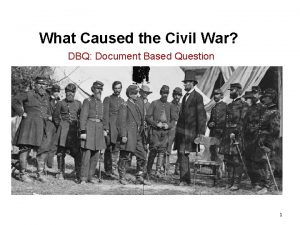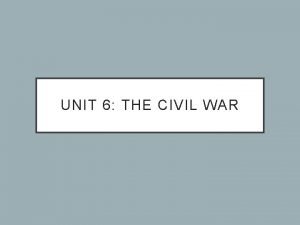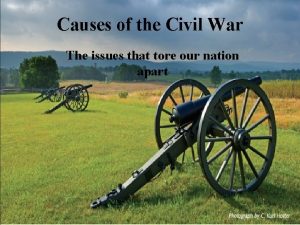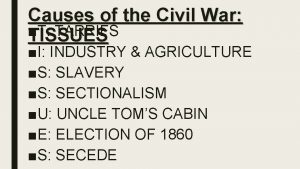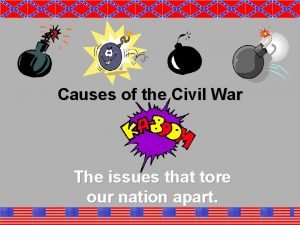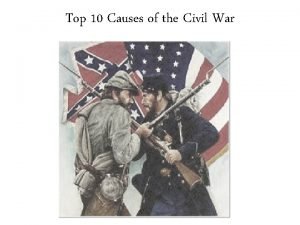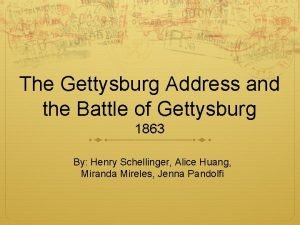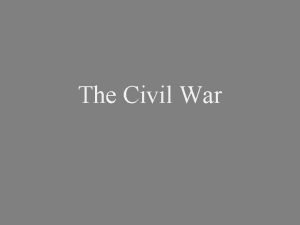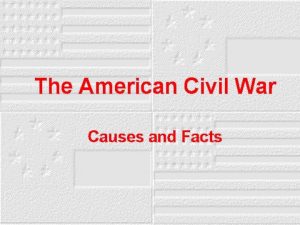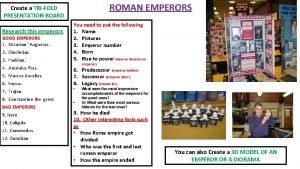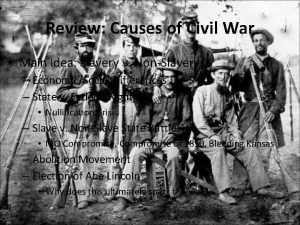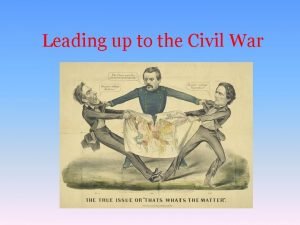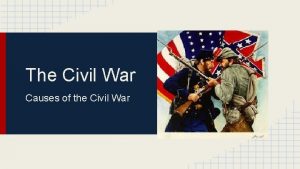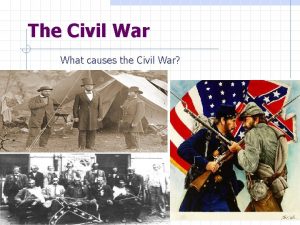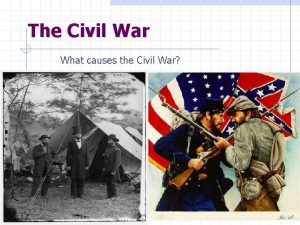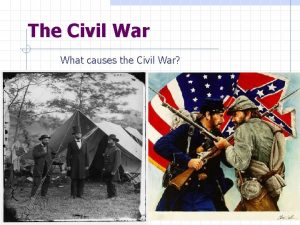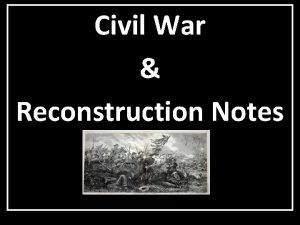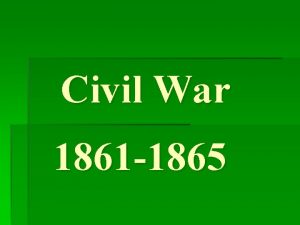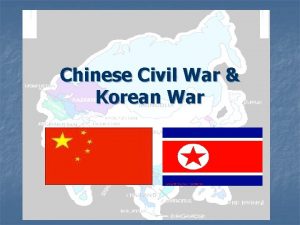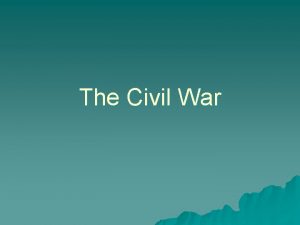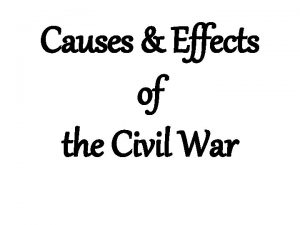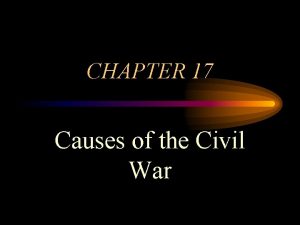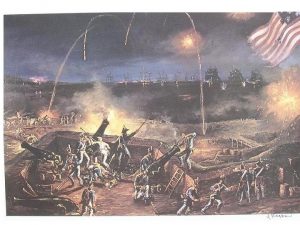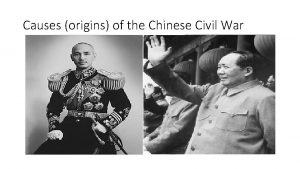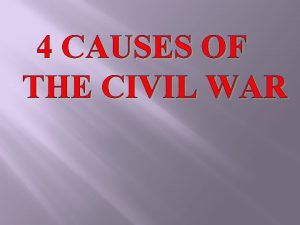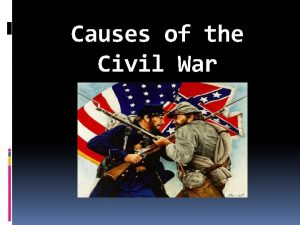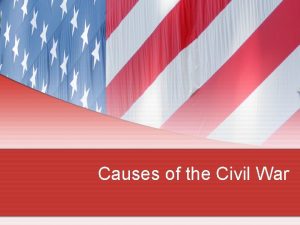Civil War Differences Causes Causes of the Civil























- Slides: 23

Civil War Differences & Causes

Causes of the Civil War • Wilmot Proviso (1846)- a proposed bill that would outlaw slavery from any territories acquired from the Mexican War. Divided Congress along regional lines (North vs. South). Southerners prevented it from passing (Sectionalism) claiming States Rights.

Causes of the Civil War • Compromise of 1850 - California wanted to apply for statehood. Henry Clay came up with compromise to keep a balance between slave & free states. California would enter as a free state & NM, UT, NV would decide later on slavery.

U. S. Wealth 1860 Match the $ with the correct Category DOLLARS CATEGORY 1. Slave Population a. $ 3, 000, 000 2. Capital $ Manufacturing b. $ 1, 050, 000 3. Capital $ Railroads 4. Capital invested in Banks c. $ 1, 166, 422, 729 d. $ 421, 890, 095 e. $ 442, 102, 000 f. $ 1, 107, 490, 216 g. $ 63, 131, 000 h. $250, 291, 000 5. Currency in Circulation 6. Livestock 7. Expenditures of Federal Government 8. U. S. Cotton Crop

Causes of the Civil War • Fugitive Slave Lawrequires the Northern states to return runaway slaves.

• Causes of the Civil War Uncle Tom’s Cabinbook by Harriet Beecher Stowe, wrote a dramatic account of black’s suffering in the south & helped sway Northern sympathies. – President Lincoln remarked of Mrs. Stowe, as “the little lady who wrote the book who made this great war. ”

• #1 novel of the 1800’s • 2 nd best-selling book of the 1800’s. • 1 st year 300, 000 copies of the book were sold in the U. S.

Causes of the Civil War § Kansas-Nebraska Act (1854): Southern states refused to allow Nebraska as a new state. To break the deadlock, Congress passed a law allowing settlers to decide by popular sovereignty (popular opinion) if they wanted slavery. – ‘Bleeding Kansas: ’ Lots of bloodshed between pro slavery & abolitionist. D A E D 0 0 +2


Causes of the Civil War • Dred Scott Decision (1857): Dred Scott had previously lived in the free Northern states; he believed this made him free. When he was brought back to the south, he tried to sue his owner for his freedom. Supreme Court ruled that blacks were not citizens & couldn’t sue or bring cases to court.


Causes of the Civil War • John Brown’s Raid (1859): Northern abolitionist tried to lead a slave revolt. Attacked Federal arsenal at Harpers Ferry in Virginia. Caught by Federal troops- tried for treason & was hung.

• treason • noun 1. the offense of acting to overthrow one's government or to harm or kill its sovereign. • 2. a violation of allegiance to one's sovereign or to one's state.

Why does Texas get Involved? • States’ Rights • Slavery • Sectionalism • Tariffs

Episode 4 ‘Division’ • Cotton • How was cotton a contributing factor in causing the Civil War?

Differences How were the Northern & Southern states different in 1860’s?

Economic Differences South • Relied on plantation farming (cotton). • Invested in slaves rather than factories. • Without factories, southern economy relied on goods from the North & Europe. North • Had lots of factories & businesses. • Many large cities (Large population). • Lots of Railroads connecting eastern cities & western farming regions.

South • Population: 29% • Railroad Mileage: 29% • Manufacturing Plants: 15% • Total U. S. Workers: 8% • Resources: Not as good. • Leadership: General Robert E. Lee • Naval Power: Few War Ships • Geography: Defensive War (On their own soil) North • Population: 71% • Railroad mileage: 71% • Manufacturing Plants: 85% • Total U. S. Workers: 92% • Resources: More & Better • Leadership: Abraham Lincoln • Naval Power: Powerful Navy • Geography: Offensive War

North Social Differences ØAbolition movement began in the North. • Many believed slavery was morally wrong. • Others opposed because slavery was an economic threat to them. • Many Northerners were still racist.

Social Differences South § Defended slavery as a necessity. § Claimed they helped slaves by introducing them to Christianity, providing them with food, clothing,


The End

 Why was the civil war considered the first modern war
Why was the civil war considered the first modern war Toward civil war lesson 3 secession and war
Toward civil war lesson 3 secession and war What caused the civil war dbq
What caused the civil war dbq Civil war causes
Civil war causes Myjeopardy
Myjeopardy What were the 4 main causes of the civil war
What were the 4 main causes of the civil war Tissues causes of civil war
Tissues causes of civil war What are the 3 main causes of the civil war
What are the 3 main causes of the civil war Causes of the civil war
Causes of the civil war Glorious revolution causes
Glorious revolution causes Civil rights and civil liberties webquest
Civil rights and civil liberties webquest Civil war map activity
Civil war map activity Gtech gettysburg
Gtech gettysburg English civil wars timeline
English civil wars timeline What led to civil war
What led to civil war Civil war facts
Civil war facts Civil war staar questions
Civil war staar questions Civil war trifold
Civil war trifold Conclusion of the civil war
Conclusion of the civil war Ppt
Ppt Cotton diplomacy
Cotton diplomacy What led to the civil war
What led to the civil war Civil war trading cards project
Civil war trading cards project Unit 4 civil war and reconstruction
Unit 4 civil war and reconstruction


